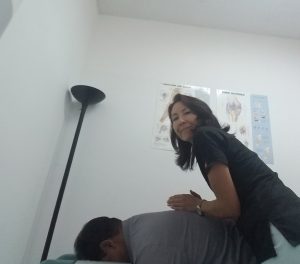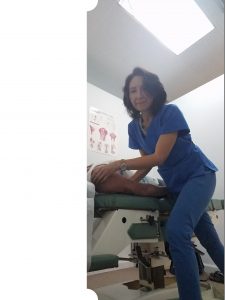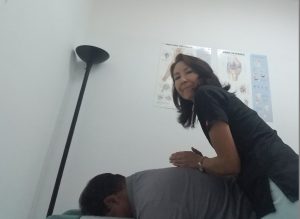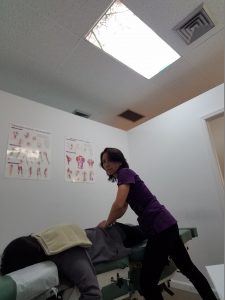
From Dr. Natalie Meiri’s Clinical Pearl Stories:
Author: Natalie Meiri, D.C. Posted: 7/24/21
This was a 49 year old male patient with chief complaints of neck pain and vertigo. To be HIPAA compliant, I will call him Andy instead of his real name. Andy had a car accident which caused his neck pain and vertigo. Moreover, he experienced the vertigo with maintaining certain head positions.
After the auto accident, Andy was treating with me for his spinal injuries. However, the vertigo/ dizziness was so terrible he also went to see a ear-nose-throat specialist. This was to rule out any possible complications related to his ear-nose-throat and the vertigo.
In Andy’s vertigo case, it wasn’t surgical and he didn’t want drugs. The canalith repositioning maneuver by the ENT specialist wasn’t successful. He decided to just have chiropractic treatment for the vertigo symptoms and do the physical therapy exercises at home.
Andy’s Examination, X-rays and
Treatment for Vertigo
The x-rays taken in my office showed findings consistent with a sprain with myospasm (muscle contraction) in his cervical (neck) and thoracic (mid back) spine. Upon examination, I found positive tests for a cervical (neck) sprain with thoracic (midback) myalgia (muscle pain) diagnoses.
Firstly, he received chiropractic adjustments/ manipulation to his cervical (neck) and thoracic (mid back) spine along with soft tissue work (myofascial release, pressure point and various post isometric relaxation procedures) and exercises to continue at home. Secondly, recommendations were made on diet/lifestyle:
-Distribute food and fluid intake evenly throughout the day.
-Avoid foods and beverages that have a high salt or sugar content.
-Drink adequate amounts of fluid daily.
-Avoid foods and beverages with caffeine.
-Limit or eliminate alcohol consumption.
-Do not use tobacco.
-Ginger may ease vertigo symptoms, like nausea and lightheadedness.
Thirdly, I did several homeopathic consultations with Andy and prescribed a number of homeopathic medicines.
Andy responded well to his chiropractic treatment for vertigo. Furthermore, his neck and mid back spinal injuries healed. Finally, Andy’s vertigo decreased in frequency and intensity gradually and then resolved.
What is vertigo?
Vertigo is the sensation that you, or the environment around you, is moving or spinning.
This feeling may be barely noticeable or it may be severe. So severe that you find it difficult to keep your balance and do daily tasks.
Attacks of vertigo can develop suddenly and last for a few seconds, or they may last much longer.
Vertigo is commonly caused by a problem with the way balance works in the inner ear, although it can also be caused by problems in certain parts of the brain. Additionally, it can be caused by neuromusculoskeletal problems in your neck.
Depending on the condition causing vertigo, you may experience additional symptoms, such as ringing in your ears (tinnitus) and hearing loss.
Here are some causes of vertigo:
Cervicogenic Vertigo–
Cervicogenic means the problem is coming from a source in the neck. Either overstimulation of upper cervical (neck) proprioceptors or degeneration of these proprioceptors occurs with cervicogenic vertigo. A proprioceptor is a sensory receptor which receives stimuli (regarding position and movement) from within the body. Additionally, proprioceptive pathways may cause an imbalance of information. This leads to a perception of vertigo or disequilibrium. Chiropractic adjustments stop the overstimulation and balance out any misinformation in the pathways.
Benign paroxysmal positional vertigo
BBPV is vertigo lasting seconds to a couple of minutes. BPPV is due to “degenerative debris” (small bits of calcium carbonate) floating in the semicircular canal in your ear. The semicircular canals are three tiny, fluid-filled tubes in your inner ear that help you keep your balance. Common head positioning changes causing BBPV are extension (i.e. looking up at a shelf) or rotation, bending over and straightening back up, or rolling over in bed. Trauma and age appear to be important factors. BPPV is the most common cause of vertigo.
Meniere’s disease
These are paroxysmal (sudden and recurrent) attacks of severe vertigo accompanied by low-tone hearing loss, low-tone tinnitus, and a sense of fullness in the ear. The episodes last for several hours to a day. Vertigo-free periods last for weeks or months. Hearing loss is progressive, while vertigo attacks appear to “burn out” over time. Some patients have sudden “drop” attacks without loss of consciousness. Increased fluid maybe causing distention and symptoms.
Causes of Vertigo Due to an Infection:
Vestibular Neuronitis (Neuritis)
Vestibular Neuronitis is most commonly associated with an ear infection. So severe vertigo occurs rather suddenly and lasts for days to weeks. There is often associated nausea and vomiting. The cause is unknown. However, it may be due to a viral infection of the vestibular nerve (nerve of inner ear). Patients report a respiratory infection prior to this vertigo. Similarly, of patients with vestibular neuritis, 50% report having had a common cold.
Labyrinthitis –
The patient complains of an acute onset of vertigo with or without hearing loss. A viral or bacterial infection (ie ear infection) causes damage to the inner ear leading to complete destruction of the inner ear.
Symptoms associated with Vertigo
Symptoms of vertigo are all dependent on each individual and may vary from this list. Some common vertigo symptoms may include:
- Swaying
- Unbalanced
- Headache
- Sweating
- Ringing in ears
- Loss of hearing
- Nausea
- Spinning
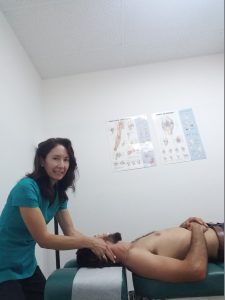
Common natural vertigo treatments include:
- Chiropractic Manipulative therapy
- Physical therapy (exercises which aim to strengthen the vestibular system)
- Epley Canalith repositioning maneuver- (non-invasive treatment for the most common cause of vertigo, benign paroxysmal positional vertigo (BPPV). Epley Maneuver is a type of maneuver that helps to clear the debris that is settling in the ear. And if there is debris that collects, it will cause you to experience symptoms of vertigo.
- Diet/lifestyle changes
Meiri Chiropractic serving West Palm Beach, Jupiter, Palm Beach Gardens and North Palm Beach offers excellent chiropractic treatment for vertigo. Call us in West Palm Beach at 561-253-8984 to schedule an appointment or to find out more about Vertigo and Dizziness: The Causes and How Chiropractic Can Help.
Meiri Chiropractic
561-253-8984
